Cathay, Chitral, Comorin, Carthage, Corfu and Canton
 German unrestricted submarine warfare against British shipping during World War I had resulted in the loss of 44 fine passenger and cargo-liners of the Peninsular and Oriental Steam Navigation Co. Ltd. In 1919, Chairman Lord Inchcape (born James Mackay in 1852) and his fellow directors of Lord Balfour, Lord Burghclere, Lord Chalmers, Lord Kilbracken, Sir Charles Addis, Sir Duncan Carmichael, Sir Montagu Turner, Sir Walter Lawrence, Hon. Alexander Shaw (son-in-law of Lord Inchcape), and Ernest Cunard were faced with a rebuilding programme of massive proportions. They decided upon a huge new fleet of nineteen deep-sea passenger liners to be ordered in stages for their very important Indian, Far East and Australian services to be completed by 1930, as follows:-
German unrestricted submarine warfare against British shipping during World War I had resulted in the loss of 44 fine passenger and cargo-liners of the Peninsular and Oriental Steam Navigation Co. Ltd. In 1919, Chairman Lord Inchcape (born James Mackay in 1852) and his fellow directors of Lord Balfour, Lord Burghclere, Lord Chalmers, Lord Kilbracken, Sir Charles Addis, Sir Duncan Carmichael, Sir Montagu Turner, Sir Walter Lawrence, Hon. Alexander Shaw (son-in-law of Lord Inchcape), and Ernest Cunard were faced with a rebuilding programme of massive proportions. They decided upon a huge new fleet of nineteen deep-sea passenger liners to be ordered in stages for their very important Indian, Far East and Australian services to be completed by 1930, as follows:-
- A new Indian service flagship in Viceroy of India with 672 passenger berths on the Bombay direct service.
- Five new Branch Line passenger steamers for the Australian service via Suez in Ballarat, Baradine, Bendigo, Barrabool and Balranald with a total of 2,455 berths plus a number of deck passengers.
- Four new ‘M’ class passenger liners for the Australian service via Suez in Moldavia, Mongolia, Mooltan and Maloja with a total of 2,120 passenger berths.
- Four new ‘R’ class passenger liners for the Bombay direct service in Ranpura, Ranchi, Rawalpindi and Rajputana with a total of 2,400 passenger berths.
Five new ‘C’ class intermediate passenger liners for the Australian service via Colombo and the Far East service in Cathay, Chitral, Comorin, Carthage and Corfu with a total of 1,695 passenger berths. A further superior ‘C’ class vessel was completed shortly before the outbreak of World War II as Canton, with ‘A’ deck having a complete run of First Class staterooms to accommodate a total of 480 passengers, making the total for the six ‘C’ class of 2,175 passenger berths.
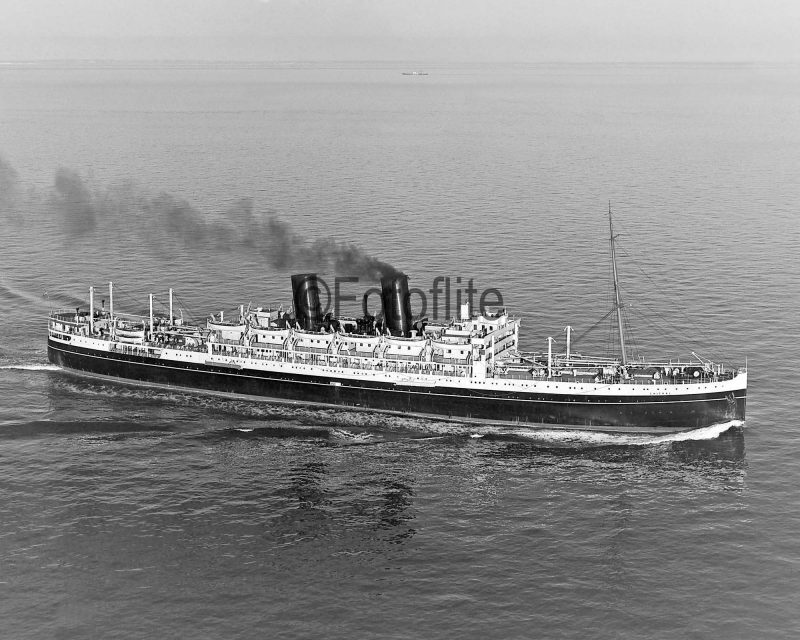
The provision of a total of 9,400 First Class and Second Class berths in brand new liners, plus 600 deck passengers on the new Branch Line steamers, to give ten thousand new passenger berths was a monumental undertaking even for the British premier passenger liner company, and the six ‘C’ class intermediate liners were to play an important part in the company strategy. Lord Inchcape was able to report on 7th December 1921 at the Annual General Meeting that ‘We are recovering, and I venture to think that we shall shortly be on the upgrade in shipping generally, and if so, this great company will be amongst the leaders in enterprise and in increased prosperity.’
A large proportion of the cargo spaces of the ‘C’ class were insulated for the carriage of refrigerated meat, fish and fruit when used on the Australian route. The first trio of the ‘C’ class were given quadruple expansion steam engines, whereas the second trio, including Canton, were given more powerful steam turbines that gave an ‘all-out’ speed of twenty knots and a service speed of eighteen knots.
The first trio of Cathay, Chitral and Comorin were delivered in 1925 for the Australian service via Suez and Colombo, with Chitral and Comorin transferred to the Far East route in 1931. Cathay also made occasional voyages to the Far East after 1931, although Comorin had returned permanently to the Australian route by the beginning of 1936.
The second trio of Carthage (1931), Corfu (1931) and Canton (1938) were built for the Far East route via Suez and India, and to handle the climatic changes for passengers and cargo of the red heat of the Red Sea and the chilling cold of Northern China. However, the lack of air conditioning in all six members of the ‘C’ class was a major problem. Swimming pools were provided for the delight of passengers in the tropics, and the style of decoration and furnishings in their public rooms was of a much simpler non-heavy type than that which characterised the heavy ornate nature of the larger P. & O. liners. In a phrase, the ‘C’ class were designed to ‘please the passenger, and not the naval architect’.
Design and Specification
The ‘C’ class were twin funnelled, twin screw liners of 15,000grt, with the first trio having overall lengths of 547.0 feet, length between perpendiculars of 522.2 feet, moulded beam of 70.2 feet, depth of 46.0 feet, and a draft of 30.2 feet. The fo’c’stle was of length 92 feet and the ‘midships accommodation block of length 255 feet, and they were given cruiser sterns. The double bottom was of length 443 feet and could hold 1,683 tonnes of oil fuel bunkers. The hull was subdivided into compartments by nine bulkheads with the collision bulkhead reaching all the way up to the weather deck. The cubic capacity of the six holds was 452,000 cubic feet (grain) and 424,000 cubic feet (bale) with a deadweight of 10,300 tons.
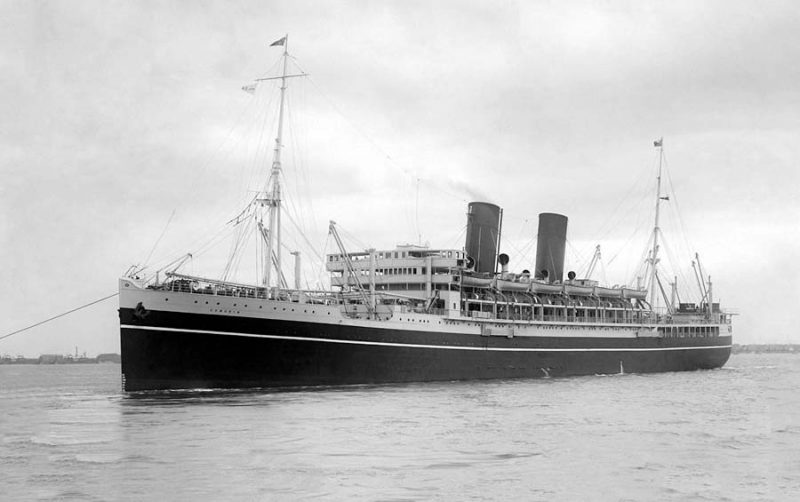
The second funnel was a dummy, with the exhaust smoke from the six boilers trunked through the forward funnel, and the steam used in the quadruple expansion steam engines to give service speeds of sixteen knots. The hull had seven decks and six holds and hatches, the latter trunked through all of the decks of the hull. Cathay and Comorin were completed by the Whiteinch yard of Barclay, Curle and Co. Ltd. on the Clyde in March and April of 1925 as yard numbers 602 and 603, whereas their sister Chitral came from the Linthouse yard on the Clyde of Alex. Stephen and Sons Ltd. in June 1925.
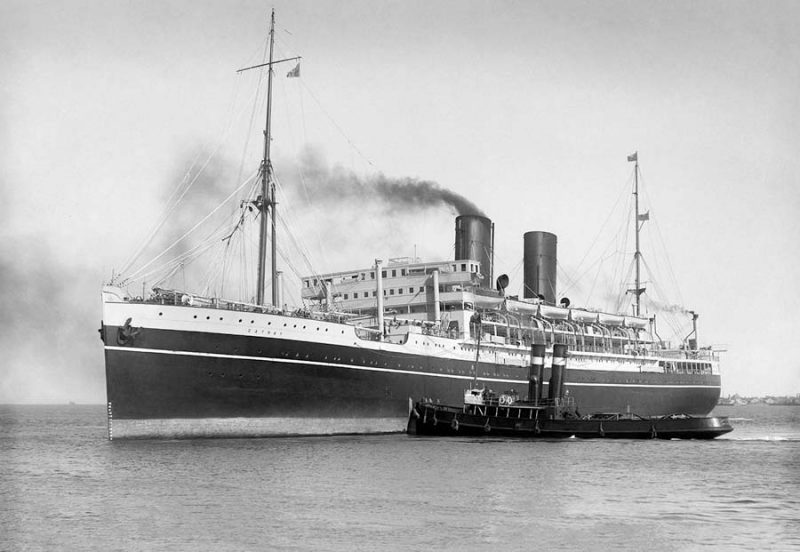
Cathay and Comorin carried 203 First Class passengers, and 103 in Second Class, whereas Chitral carried thirty more passengers with 196 in First Class and 135 in Second Class. Cathay was launched by Lady Inchcape on 31st October 1924, with Comorin launched by Mrs. Alexander Shaw, one of her daughters on the same day. Chitral was launched on 27th January 1925 by Hon. Elsie Mackay, youngest daughter of Lord Inchcape. The cost of the first trio was around £740,000 per vessel. The maiden voyages from London to Sydney were on 27th March, 25th April and 3rd July 1925 respectively.
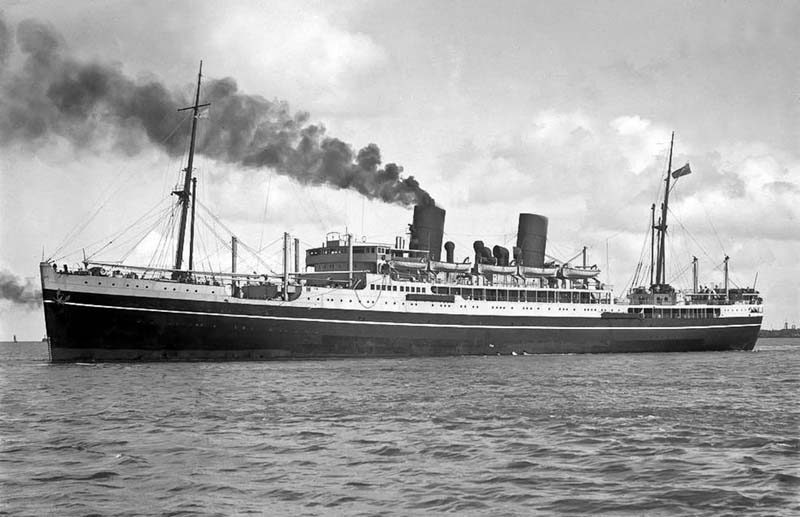
Cathay, Comorin and Chitral initially had stone coloured upperworks, two black funnels, a black hull with a thin white hull line just below the forward and aft well decks. Two very tall masts were crossed with high topmasts, and there was a very good complement of derricks on these masts and four sets of posts for cargo handling. The colours were changed in 1934 to buff upperworks, fo’c’stle, and hull between the forward and aft well decks, with a thin white line one deck lower than before. Cathay, Comorin and Chitral continued to voyage homewards from Sydney, calling at Hobart during the apple season of February and March, Melbourne, Port Adelaide, and Fremantle, with a call at Bombay from 1931.
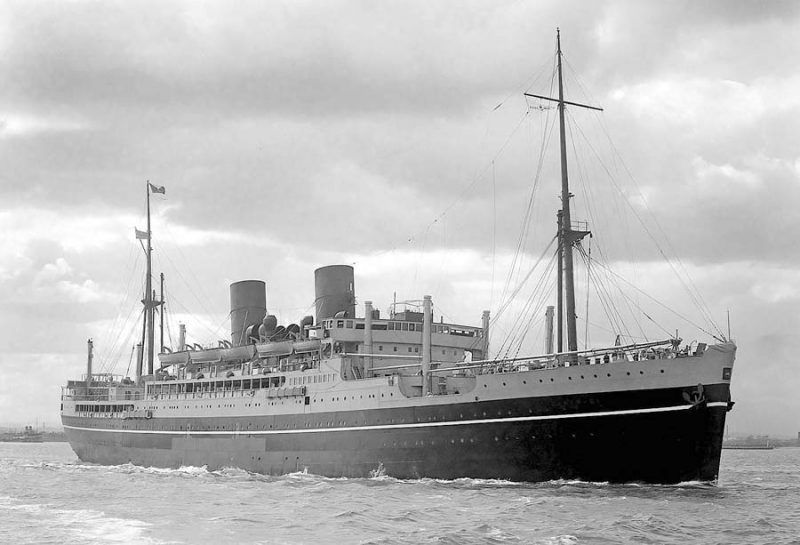
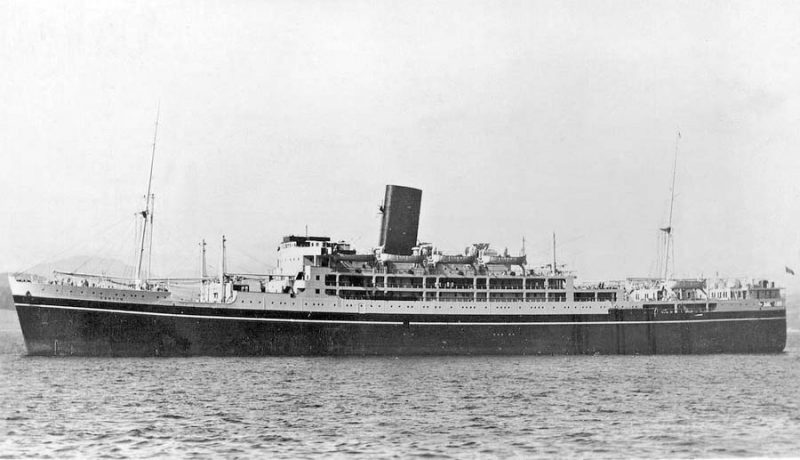
The better De Luxe First Class cabins could then be used to accommodate important passengers e.g. David Lloyd George and author H.G. Wells, as well as the worthy members of the British Raj and Governors of the important States e.g. Lord Ronaldshay, Governor of Bengal who later took the title of the Marquis of Zetland, as well as the ‘Nawabs’ of India (Indian princes) or simply those who had been awarded the ‘Nawab’ title as a personal distinction, similar to members of the British peerage, and who belonged to families who had never ruled a princely State. The De Luxe First class staterooms were designed with extra space, and were outside staterooms with four pane windows, luxury double beds with washbasin between them, and light mahogany side table, drawers and easy chairs. The seven decks on the ships were as follows:-
- ‘A’ Deck Officer cabins and promenading space
- ‘B’ Deck First Class passengers forward, Second Class aft, First Class public rooms
- ‘C’ Deck First Class passengers forward, Second Class aft, Second Class public rooms
- ‘D’ Deck First Class passengers forward, Second Class aft, Second Class public rooms and Second Class Dining Room
- ‘E’ Deck First Class Dining Room, Second Class passengers
- ‘F’ Deck Second Class passengers forward and aft
- ‘G’ Deck was a half deck below ‘F’ Deck in the forward cargo holds only
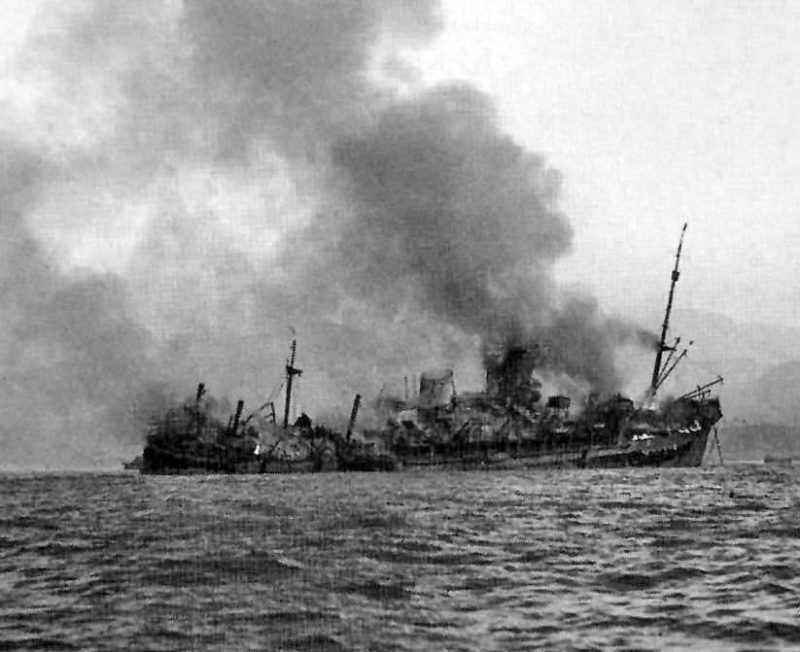
The crew of the first trio of the ‘C’ class numbered 278, with a Master and seventeen navigating and engineering officers, 29 petty officers, 47 able seamen, 54 greasers and firemen, and 131 stewards. The officers changed into ‘whites’ in tropical waters, and erected a small canvas swimming pool, usually of somewhat unsteady proportions, on the after deck for the benefit of passengers to cool off. The stewards and officers were always on call for the needs of passengers, either food and drinks or to help with ship’s games and amusements.
The fortnightly P. & O. passenger and mail service to Australia was shared by three members of the ‘C’ class and the four members of the ‘M’ class, with three ships on the outward six week voyage and three on the homeward voyage, and allowing one vessel to be away on annual refit. Comorin and Chitral had low pressure Bauer-Wach exhaust turbines and Wyndham heaters added to their quadruple expansion steam engines in 1931/32 to boost their service speeds to 17.5 knots.
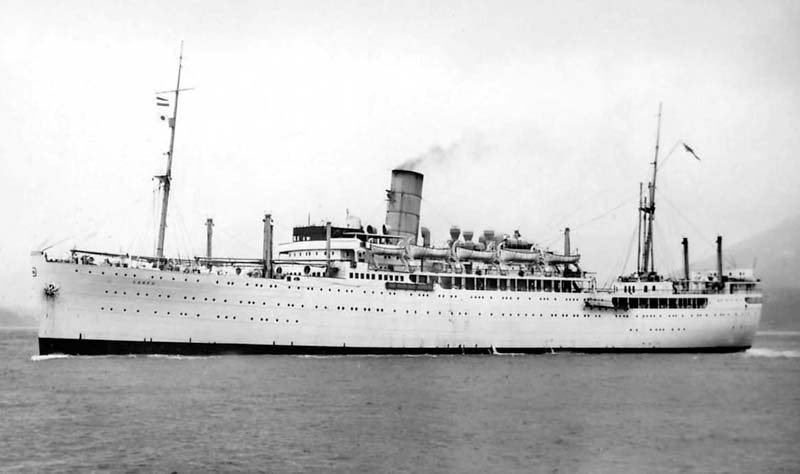
Comorin caught fire on 12th March 1930 while anchored in Colombo harbour and over 30,000 meat carcasses were destroyed. Cathay lost a propeller on 14th December 1933 while trying to make up time between Colombo and Fremantle, and had to wait in Australia while a replacement was brought out in the white hulled three yellow funnelled Strathnaver.
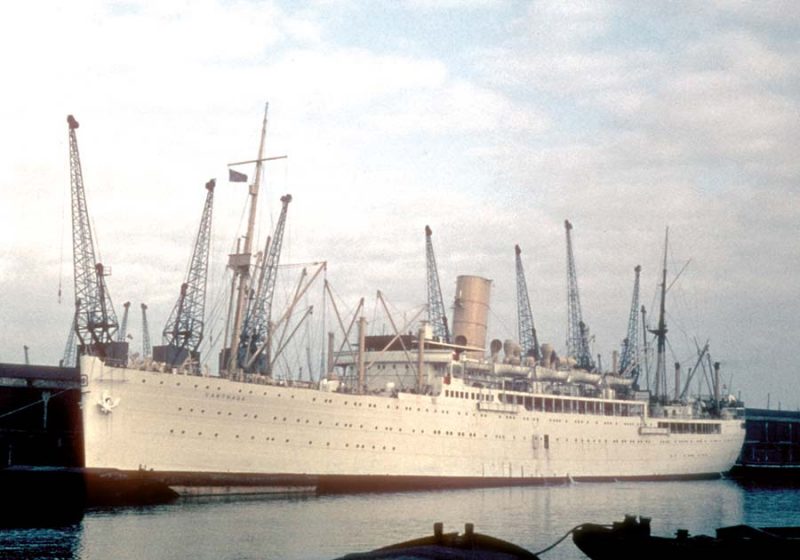
Chitral was narrowly missed by bombs from a Spanish aircraft in July 1936 while anchored at Gibraltar duringf the Spanish Civil War.
Corfu and Carthage were ordered in 1929 as Yard numbers 534 and 535 from the Alexander Stephen and Sons yard on the Clyde and completed in September 1931 and November 1931. Corfu was launched on 20th May 1931 by the Hon. Patricia Mackay, grand-daughter of Lord Inchcape, while Carthage was launched by Miss Jean Shaw, daughter of Hon. Alexander Shaw, Deputy Chairman of P. & O., on Tuesday 18th August 1931 and made her maiden voyage on 8th January 1932 to the Far East. They were five feet shorter in length than the original ‘C’ class trio of Cathay, Comorin and Chitral, and had slightly shorter fo’c’stle and ‘midships accommodation blocks at 76 feet and 246 feet respectively.
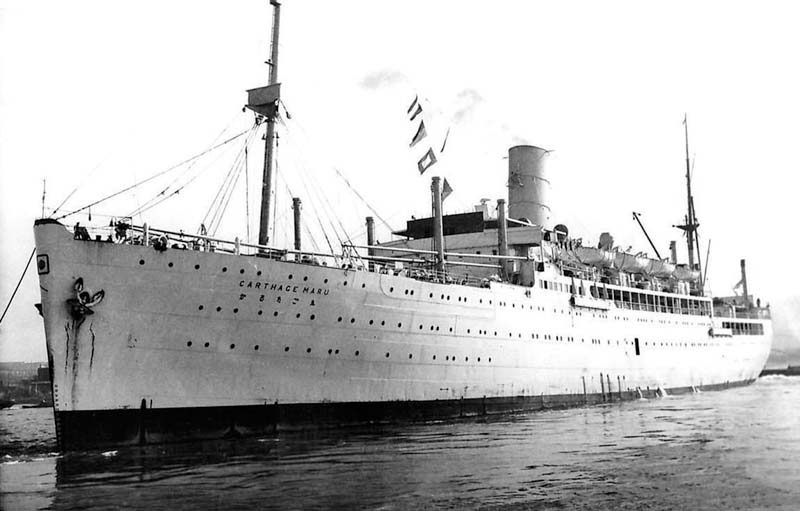
Their funnels were shorter in height than those of the original trio, and they were intended instead for the Far East run to Northern China and were thus given greater oil fuel bunker capacity in their double bottoms at 2,568 tonnes. The six Parsons geared turbines delivered 14,000 shaft horse power to twin propellers to give a maximum flat out speed of 19.5 knots and a service speed of eighteen knots.
The passenger complement was 178 in First Class and two hundred in Second Class. Carthage made a single voyage on the Australian route via Bombay and Colombo in April 1932. She sank a lighter in Keppel harbour in February 1935, and damaged herself exactly four years later when she hit the pier at Yokohama.
On Corfu and Carthage, the most elegant First Class public room was the Lounge and Music Room, located at the forward end of ‘B’ Deck. The twinkling notes of a grand piano provided the perfect background music for passengers sitting at tables for four or on soft sofas and easy chairs. The latter were upholstered in Bombay brocade, a rich fabric with a silky finish and woven with a raised pattern. The room was also used for reading and writing, and fitted with Chinese patterned carpets, with a full range of books held in glass fronted library shelves, with tables for writing at one end of this exquisite room.
The final vessel of the ‘C’ class, and very much an afterthought, was the more powerful turbine driven Canton, differing from the earlier quintet in only having one funnel.
She was ordered from the Linthouse yard of Alexander Stephen and Sons Ltd. in 1935 as yard number 557 and was launched on 14th April 1938 by Miss Thalia Shaw, daughter of Lord Craigmoyle (1883-1944), recently retired Chairman of P. & O., and was completed four months later with a gross tonnage of 15,784. She cost £820,000 and her maiden voyage started from Southampton on 7th October 1938 for all Indian ports, Singapore and Hong Kong but was marred by a brief grounding at Grays shortly after casting off.
She differed from her earlier ‘C’ class members in that ‘A’ deck was given a full complement of First Class staterooms. She thus had a much greater passenger complement of 298 in First Class and 244 in Second or Tourist Class, and ‘D’ Deck also projected forward over number three hatch and hold. Powerful Parsons single reduction geared turbines of 18,500 shp gave a ‘flat-out’ speed of twenty knots and a service speed of eighteen knots. Canton was fitted with ten lifeboats (six carrying 99 persons, two carrying 94 persons and two carrying 50 persons) on Welin-Maclachlan davits, but they were not needed to be lowered after the collision with the Messageries Maritimes liner Marechal Joffre on 30th March 1939 in fog off Hong Kong, and Canton spent three weeks in the Taikoo dry-dock for repairs to her starboard side shell damage near the engine room.
Canton was given a number of elegant and functional public rooms, including:-
First Class Dining Room was on ‘E’ deck panelled in primavera wood with bandings of Queensland walnut and sycamore. Tables for two, four and six diners gave a sitting of 260 persons. The armchairs were upholstered in hide to match the colour of the paintwork, and mirrors over the sideboard and in many other parts of the room increased the light available in the room.

First Class Music Room and Lounge was on ‘B’ Deck and had tall casement windows at the forward end and at the sides to give all round brightness. A mantelpiece at the aft end was finished in moulded sycamore and elm burr surrounding the radiant fire. A large painting of Canton by the well known maritime artist Norman Wilkinson R.O.I. hung above the mantelpiece. A Chinese influence was evident in the carpets, furnishings and fabrics with the predominant colours of the room being blue and fawn.
First Class Verandah Cafe was reached by moving aft on ‘B’ Deck from the First Class Music Room and Lounge through two side corridor rooms, arranged port and starboard of the engine casing and given over to dancing space. Coral and fawn coloured fabrics of the seats, and Canadian wooden panelling contrasted with African sapele wood and bleached mahogany in these side rooms. An open air swimming pool was then reached before entering into the First Class Verandah Cafe. Glazed double doors, full height large teak windows, and a bar at the forward end gave the room a spacious feeling with cane chairs, hardwood furniture, hide and printed linen accessories, with blue and fawn being the predominant colours.
Second Class Dining Room on ‘D’ Deck sat 224 persons in small groups of two, four and six tables and was of almost the same quality as the First Class Dining Room, but of a simpler but still excellent standard. Light oak tables with seats covered in hide, with panelling in chestnut and maple, excellent serving sideboards and dumb waiters.
Second Class Smoking Room was just aft of the Second Class Dining Room and was panelled in oak to give a modern version of an old style period room complete with large fireplace. The furniture was arranged in groups of chairs and settees which were covered in grey green hide.
Second Class Lounge on ‘C’ Deck had a cosy feeling with many types of light woods used in its fitting out e.g. panelled walls of Queensland maple, light wooden chairs and tables, and a fireplace set low in a long and very beautiful wooden surrounding.
World War II Careers Of The ‘C’ Class
Cathay
On 25th August 1939, Cathay was requisitioned by the Admiralty and converted at Bombay for service as an Armed Merchant Cruiser (A.M.C.). The second dummy funnel was removed and eight 6-inch and two 3-inch guns were secured to her decks. She began her naval career in October 1939 patrolling on the Bombay to Durban shipping lanes. A small troop transport convoy sailed from Gourock for Freetown in June 1941 consisting of the small naval survey vessel Challenger (J98), commanded by Commander W.C. Jenks, leading the converted Booth Line Anselm 5,954/35, completed by Denny, but now converted into a troopship carrying 1,210 R.A.F. and military personnel, Cathay to the rear of Anselm as close gun support, with corvettes Petunia (K79), Lavender (K60) and Starwort (K20) deployed to port, starboard and astern of the small convoy.
A German long range Condor aircraft spotted the convoy to the north of the Azores in position 44°25′ North, 28°35′ West, and directed U96 to reach the convoy on 5th July 1941, firing a full salvo of four torpedoes at the centre of the convoy. However, it was the valuable troop transport Anselm that was hit by two of the four torpedoes, and she had sunk within 22 minutes. The crew launched all but one of the lifeboats, but four crew members and 250 members of the service personnel drowned. Cathay picked up the survivors, with the three corvettes immediately counter attacking the U-boat with 26 depth charges, severely disabling U96 and which only just managed to reach her French base. The men struggling in the sea were close to the exploding depth charges, thus the depth charging attacks had to be broken off. Cathay later landed all survivors at Freetown.
Cathay was converted into a troop transport after being returned from naval duties on 5th February 1942, and a ten week spell at the Brooklyn yard of the Bethlehem Steel Corporation yard. Six months later, Cathay was selected as one of the many British and American troopships for Operation Torch, the Allied troop landings in French North Africa from Casablanca to Algiers. She disembarked her troops to the west of Algiers on 8th November 1942 and then moved along the coast to Bougie three days later. However she was hit by German bombers at 1330 hours on that day with one person killed in the explosions and the ship heavily on fire. The order to abandon ship was given at 1900 hours on the same day and all of the remaining crew were picked up by Karanja of British India Line. A delayed action bomb exploded in the galley at 2200 hours and the ship was now a mass of flames, with her ammunition exploding on the following day, and she capsized onto her starboard side and sank, extinguishing the huge pall of smoke that could be seen many miles away.
Comorin
Comorin was converted into an Armed Merchant Cruiser (A.M.C.) in a British yard, and served on the Northern Patrol for North Atlantic convoy duties for the next eighteen months. On 6th April 1941, she caught fire off Sierra Leone whilst patrolling in heavy seas and gale force winds. The crew were taken off by destroyers including H.M.S. Broke, with only twenty men lost. Sir Peter Scott of wildlife fame, and a superb artist of the Slimbridge wildlife refuge in Gloucestershire, was First Officer of Broke.
Chitral
Chitral was also converted into an Armed Merchant Cruiser (A.M.C.) by her builders, after requisition on 30th August 1939 and her aft funnel was removed and seven 6-inch and two 3-inch guns fitted. In September 1939 she made three trooping voyages to Reykjavik as part of the reinforcement of the garrison in Iceland. On 20th November 1939, she intercepted the German cargo ship Bertha Fisser, which was scuttled by its crew to avoid capture. After her similarly converted P. & O. consort Rawalpindi was engaged by the German heavy cruisers Scharnhorst and Gneisenau for forty minutes off Iceland on 23rd November 1939, her damage was so severe that she broke in two after many shell hits. Some 265 crew were lost including her brave Captain E.C. Kennedy R.N. but her escorted convoy scattered safely. Chitral rescued the survivors of the Rawalpindi.
In September 1941, Chitral was transferred to the East Indies Fleet and remained in the Indian Ocean until the end of 1943. In April 1944, Chitral arrived in Baltimore to be converted into a troopship by the Maryland Dry Dock Company, during which her second funnel was replaced, and she operated as such for the next three years from July 1944 until July 1947. On 17th October 1947, she was returned to her owners and was reconditioned by R. & H. Green and Silley Weir Ltd. in London with her mainmast removed.
Carthage
In September 1939, Carthage was converted into an Armed Merchant Cruiser (A.M.C.) at Calcutta, after discharging her passengers and cargo at Colombo. The aft funnel was removed and she was fitted with eight 6-inch and two 3-inch guns. She was commissioned on 20th December 1939 and served in the Indian Ocean on convoy escort duties. On 3rd November 1941, she was a unit of a force that intercepted Vichy French ships to the south west of Madagascar. She then towed the immobilised Cap Padaran 36 miles to Port Elizabeth. She returned to the Indian Ocean in August 1942 after a four month refit at Southampton, a serious fire in her number four hold delayed her departure from the Solent. On 24th November 1942, she rescued four Indian seamen survivors from the torpedoed British India Line passenger ship Tilawa. She decommissioned at Swansea on 29th October 1943 and sailed to Norfolk (Va) for conversion into a troopship, and she served in that capacity for three years from New Year’s Day of 1944.
Corfu
Corfu was requisitioned by the Admiralty on 14th September 1939 and converted into an Armed Merchant Cruiser (A.M.C.) equipped with eight 6-inch and two twelve pounder guns at Belfast. On 10th July 1940, she collided with the British aircraft carrier Hermes in convoy off Freetown and was badly damaged with a hole of length thirty feet in her starboard bow and was abandoned. She was reboarded later in the same day and subsequently taken in tow by H.M.S. Milford and the Dutch tug Donau and reached Freetown three days later stern first. She was beached for repairs there to her bow and re-entered service in early 1942. She continued to serve as an A.M.C. equipped with a Kingfisher reconnaissance plane until converted into a troopship in February 1944 at Mobile (Alabama), and was in the first convoy to re-enter Singapore harbour in September 1945. She continued in use as a troop transport until returned to her owners in 1947. She had sailed 200,000 miles as an Armed Merchant Cruiser, and 39,161 miles as a troopship while carrying 15,028 troops.
Canton
Canton was requisitioned by the Admiralty on 19th October 1939 and converted into an Armed Merchant Cruiser (A.M.C.) by her builders and equipped with eight 6-inch and two 3-inch guns. She joined the Northern Patrol but ran aground on 9th January 1940 in bad weather on rocks off Lewis in the Outer Hebrides whilst en-route to Greenock. She was badly damaged forward with two holds flooded, but broke free of the rocks the following day after a series of full power astern refloating attempts. She was beached in Holy Loch as a temporary measure before being fully repaired at the Barclay, Curle yard on the Clyde.
She was a member of the Freetown Escort Force from August 1940 until November 1941, undergoing refits at Greenock and at New York during this time and was equipped with catapult launched Fairey Seafox aircraft.
She served on the South Atlantic Station from November 1941 to August 1942, and intercepted the German cargo ship Karnak off St. Paul’s Rocks, which then scuttled herself. During a refit on the Clyde in August 1942, she was given cranes to unload six LCA landing craft carried ‘midships, as well as an extra six inch gun, two four inch guns and a Kingfisher reconaissance seaplane for service with the Eastern Fleet at Kilindini and Colombo.
She arrived at Cape Town in May 1944 for conversion into a troopship and served in that capacity for two years until she was returned to her owners.
Post WWII Service of the Remaining ‘C’ Class
The three funnelled ‘Strath’ passenger liners Strathnaver and Strathaird were the first of a quintet of ‘White Sisters’ to enter service in 1931, and were the last legacy of Lord Inchcape when he died on 24th May 1932.
The ‘White Sisters’ had ‘hogged the limelight’ during the 1930s in P. & O. publicity on posters and paintings showing romantic voyages by Charles Edward Dixon (1872-1934), Frank Henry Mason (1875-1965) and Kenneth Shoesmith (1890-1939) e.g. passengers arriving at a North African port quay in the ship’s lifeboats, or passing through the Suez Canal with huge sand dunes to port and starboard, or anchored at Aden while refuelling with a backdrop of hills and Arab dhows, or passing under the Sydney Harbour Bridge after its completion in 1931 to reach the then P. & O. West Circular Quay berth.
The ‘C’ class also moved up the Australian east coast to berth at Hamilton Reach on the north bank of the Brisbane river. In fact, it was the black hulled ‘C’, ‘M’ and ‘R’ class passenger liners and many black hulled cargo-liners that had carried over 95% of the company trade during the inter-war years.
The P. & O. Group as a whole lost 160 ships during World War II, of which nineteen belonged to the main P. & O. fleet. The P. & O. Roll of Honour lists 123 lives that were lost on active service with another 37 dying ashore or in prisoner of war camps, with many more lost in the subsidiary companies.
The P. & O. directors were cautious in rebuilding its post-war passenger fleets, as mail contracts no longer existed going instead by air, and they were faced with the threat of all out passenger competition from air travel. Australia needed 70,000 people per annum to arrive in their country to rebuild their economy, and Chitral, Mooltan, Maloja and Ranchi remained in traditional black hulls after their post-war refits on austerity lines. They were chartered by the British Government for four years between 1948 and 1952 carrying ‘Ten Pound Poms’ to settle in Australia.
However, the remaining ‘C’ class liners of Canton, Corfu and Carthage received much more extensive post-war refits, and with well decks plated in, Corfu and Carthage became single yellow funnelled white hulled liners, along with Canton which had been built with a single funnel in 1938.
Chitral continued carrying her complement of 740 ‘austerity’ passengers in six and twelve berth cabins, the only exceptions being nine better quality two berth cabins. She began on her first voyage on 30th December 1948 carrying outbound fare assisted migrants and fare paying P. & O. passengers on homeward voyages until she was sold for breaking up at Dalmuir on 2nd April 1953.
On a few occasions, she was diverted to Indonesia on the homeward leg to collect Dutch nationals returning home to Holland. She made four return voyages each year, with her last voyage from Tilbury on 19th December 1952, and she sailed from Sydney for the last time on 4th February 1953 and arrived back at Tilbury on 18th March 1953.
Carthage resumed her P. & O. service with full fare paying P. & O. passengers in 1948 but with a white hull, and she rescued 23 crew survivors on 21st July 1958 from the Panamanian steamer Allegra which was sinking in heavy seas and Force 8 winds between Bombay and Aden.
She continued sailing to the Far East for the next three years until sold for breaking up on 13th February 1961 in Japan, her final voyage was sailed as Carthage Maru.
Corfu re-entered commercial P. & O. service on 22nd January 1949 to partner her sister Carthage, and followed her same pattern of post-war service until demolition was begun at Osaka on 17th October 1961, her final voyage to the scrapyard was as Corfu Maru.
Canton received an extensive refit that increased her gross tonnage to 16,033 before returning to her Far Eastern service with her passenger accommodation increased to 546, with 298 First Class and 248 Second Class or Tourist Class. She made her last voyage out to China in the Autumn of 1962 and arrived for breaking up at Hong Kong on 3rd October 1962.
Postscript
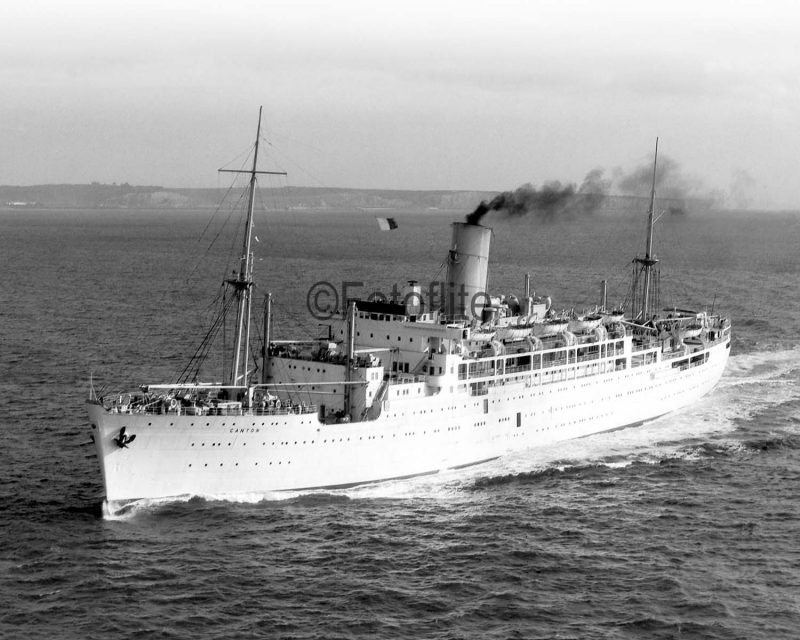
The six members of the ‘C’ class were important members of the P. & O. fleet for over 37 years between 1925 and 1962, in fact the total of their number of years in service, both peace time and wartime, was 145 years. They are most remembered on the Australian service, with calls at Bombay and Colombo, in the latter port moored to two buoys fore and aft in the big harbour, on both the outward and homeward voyages, but Carthage, Corfu and Canton served the majority of their service on the Far East service with periodic switches to the Australian route as trade dictated. Masters of the ‘C’ class during the inter-war years on the Australian route included Capt. J. Borland, Capt. C.W. Cartwright, Capt. E.B. Bartlett, Capt E.H. Starling and Capt. H.R. Rhodes, who on the homeward voyage always used the Straits of Messina as a short cut to the port of Marseille, where many of the passengers decamped into trains for a quicker return to London than the rough Bay of Biscay route.
Passenger lists of these important ‘C’ class mail steamers were always published in the newspapers in both London and Sydney on departure day, together with photographs of the important or more well known passengers. The six week voyage was not considered tedious or long as the first long range Imperial Airways flights to Brisbane and Sydney did not take off until May 1935, taking seventeen days to Brisbane and eighteen days to Sydney.
The ship’s orchestra, and self made amusements of deck tennis, bull board, whist and bridge sessions, and the incredible ship’s horse races using wooden model horses and jockeys replete with coloured jockey chest silks and jockey caps kept the passengers well occupied.
The present mode of air transport of at least a 24 hour flight from London to Sydney, taking in four and five full length feature films on the big screens, do not hold anywhere near the same appeal to myself as the longer and much more interesting sea voyages.

Cruising on the most luxurious ships in the world today to every possible world port and destination have replaced the romance of the long range P. & O. voyages to India, Australia and the Far East on the intermediate ‘C’ class liners of the inter-war years.
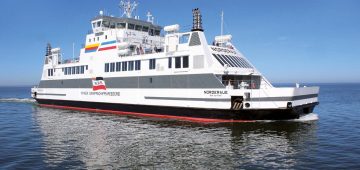



Comments
Sorry, comments are closed for this item